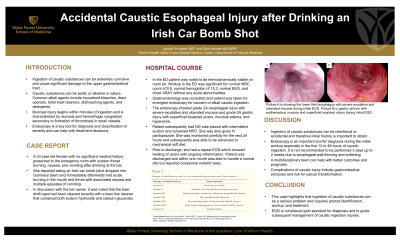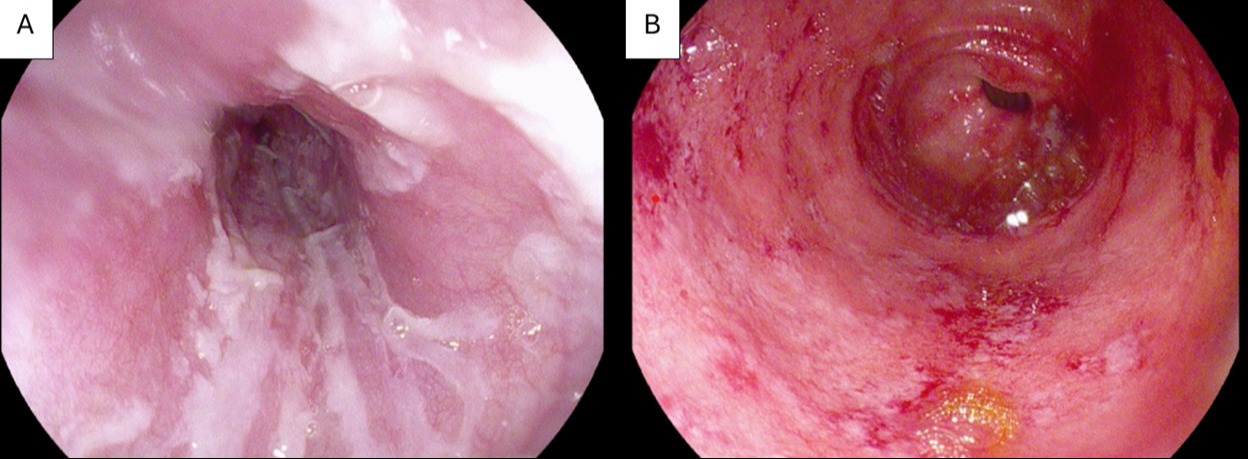Monday Poster Session
Category: Esophagus
P2248 - Accidental Caustic Esophageal Injury After Drinking an Irish Car Bomb Shot
Monday, October 28, 2024
10:30 AM - 4:00 PM ET
Location: Exhibit Hall E

Has Audio

Jigisha Srivastav, MD
Wake Forest Baptist Health
Winston-Salem, NC
Presenting Author(s)
Jigisha Srivastav, MD1, Sara Atwater, MD, MPH2
1Wake Forest Baptist Health, Winston-Salem, NC; 2Atrium Health Wake Forest Baptist, Winston-Salem, NC
Introduction: Ingestion of caustic substances can be extremely corrosive and cause significant damage to the upper gastrointestinal tract. Endoscopy is a key tool for diagnosis and classification of severity and can help with treatment decisions. Below we present a case of accidental ingestion of alkali solution causing significant esophageal and gastric injury.
Case Description/Methods: A 33-year-old female with no significant medical history presented to the emergency room with sudden throat burning, nausea, and vomiting after taking an alcoholic shot. Patient reported she was having a few drinks with her friends at the bar. She proceeded to take an Irish car bomb (shot dropped into Guinness beer) and immediately afterwards had acute burning in the mouth and throat with associated nausea and multiple episodes of vomiting. In discussion with the bar owner, it was noted that the beer draft caps had been cleaned recently with a beer line cleaner that contained both sodium hydroxide and calcium gluconate. In the emergency room (ED), the patient was noted to be hemodynamically stable on room air. Workup in the ED was significant for WBC 9.9, hemoglobin 15.3, and chest X-ray without any acute abnormalities. Gastroenterology was consulted and the patient was taken for emergent esophagogastroduodenoscopy (EGD) for concern of caustic ingestion. The EGD showed grade 2A esophageal injury with severe exudative and ulcerated mucosa and grade 2A gastric injury with superficial localized ulcers, mucosal edema, and hyperemia. Patient subsequently had an nasogastric tube placed with intermittent suction and remained NPO. She was also given IV pantoprazole. She was monitored closely for the next 24 hours and subsequently was able to be advanced to a mechanical soft diet. Prior to discharge, she had a repeat EGD which showed healing of ulcers with ongoing inflammation. Patient was discharged and within one month was able to handle a normal diet but reported occasional metallic taste.
Discussion: The case above highlights that ingestion of caustic substances can be a serious problem and requires prompt identification and treatment. Ingestion of caustic substances can be intentional or accidental and therefore initial history is important to obtain. Endoscopy is an important tool for diagnosis during the initial workup and can help guide further treatment to prevent complications such as gastrointestinal strictures and risk for cancer transformation. A multidisciplinary team can help with better outcomes and prognosis.

Disclosures:
Jigisha Srivastav, MD1, Sara Atwater, MD, MPH2. P2248 - Accidental Caustic Esophageal Injury After Drinking an Irish Car Bomb Shot, ACG 2024 Annual Scientific Meeting Abstracts. Philadelphia, PA: American College of Gastroenterology.
1Wake Forest Baptist Health, Winston-Salem, NC; 2Atrium Health Wake Forest Baptist, Winston-Salem, NC
Introduction: Ingestion of caustic substances can be extremely corrosive and cause significant damage to the upper gastrointestinal tract. Endoscopy is a key tool for diagnosis and classification of severity and can help with treatment decisions. Below we present a case of accidental ingestion of alkali solution causing significant esophageal and gastric injury.
Case Description/Methods: A 33-year-old female with no significant medical history presented to the emergency room with sudden throat burning, nausea, and vomiting after taking an alcoholic shot. Patient reported she was having a few drinks with her friends at the bar. She proceeded to take an Irish car bomb (shot dropped into Guinness beer) and immediately afterwards had acute burning in the mouth and throat with associated nausea and multiple episodes of vomiting. In discussion with the bar owner, it was noted that the beer draft caps had been cleaned recently with a beer line cleaner that contained both sodium hydroxide and calcium gluconate. In the emergency room (ED), the patient was noted to be hemodynamically stable on room air. Workup in the ED was significant for WBC 9.9, hemoglobin 15.3, and chest X-ray without any acute abnormalities. Gastroenterology was consulted and the patient was taken for emergent esophagogastroduodenoscopy (EGD) for concern of caustic ingestion. The EGD showed grade 2A esophageal injury with severe exudative and ulcerated mucosa and grade 2A gastric injury with superficial localized ulcers, mucosal edema, and hyperemia. Patient subsequently had an nasogastric tube placed with intermittent suction and remained NPO. She was also given IV pantoprazole. She was monitored closely for the next 24 hours and subsequently was able to be advanced to a mechanical soft diet. Prior to discharge, she had a repeat EGD which showed healing of ulcers with ongoing inflammation. Patient was discharged and within one month was able to handle a normal diet but reported occasional metallic taste.
Discussion: The case above highlights that ingestion of caustic substances can be a serious problem and requires prompt identification and treatment. Ingestion of caustic substances can be intentional or accidental and therefore initial history is important to obtain. Endoscopy is an important tool for diagnosis during the initial workup and can help guide further treatment to prevent complications such as gastrointestinal strictures and risk for cancer transformation. A multidisciplinary team can help with better outcomes and prognosis.

Figure: Figure 1: Picture A is showing the lower third esophagus and Picture B is showing gastric antrum during initial EGD
Disclosures:
Jigisha Srivastav indicated no relevant financial relationships.
Sara Atwater indicated no relevant financial relationships.
Jigisha Srivastav, MD1, Sara Atwater, MD, MPH2. P2248 - Accidental Caustic Esophageal Injury After Drinking an Irish Car Bomb Shot, ACG 2024 Annual Scientific Meeting Abstracts. Philadelphia, PA: American College of Gastroenterology.

